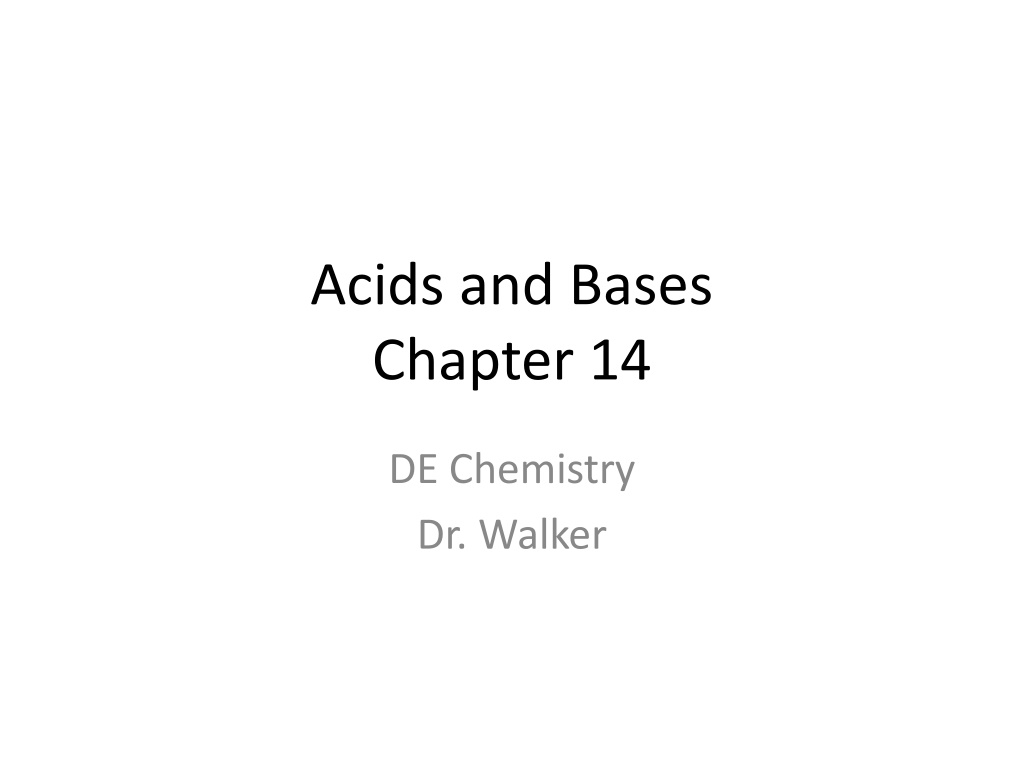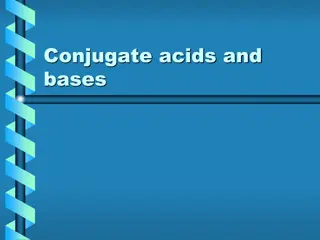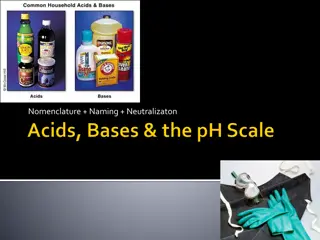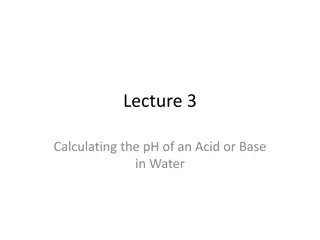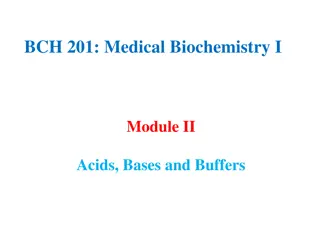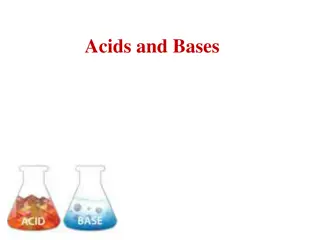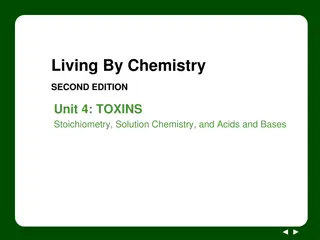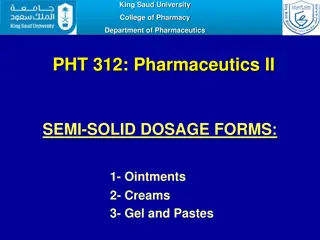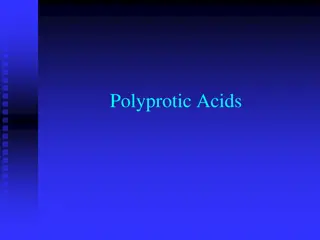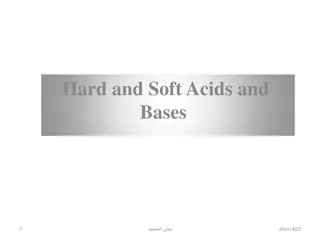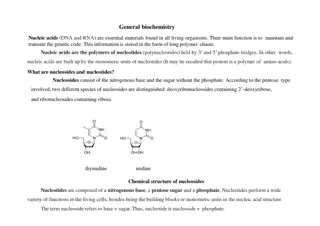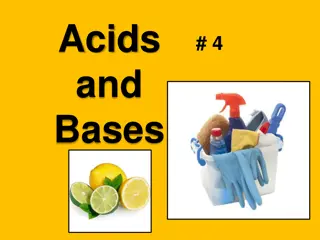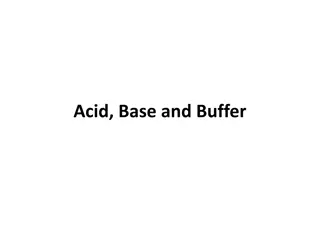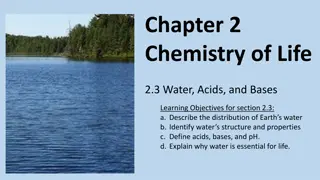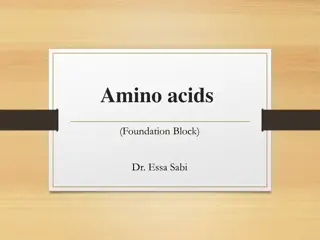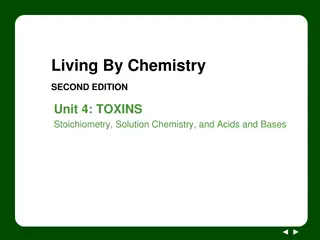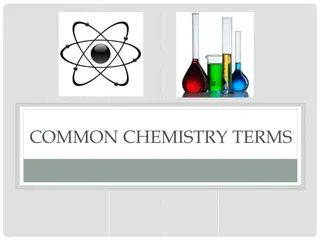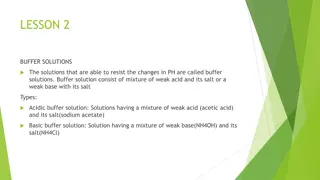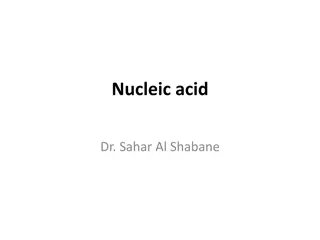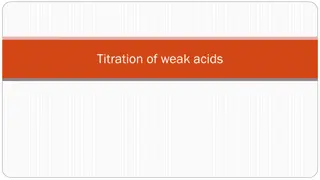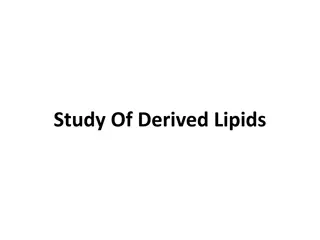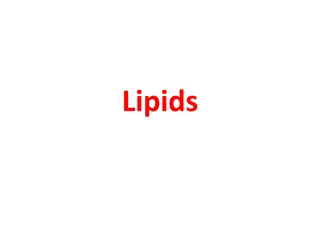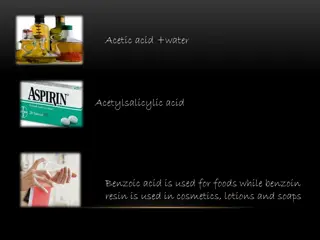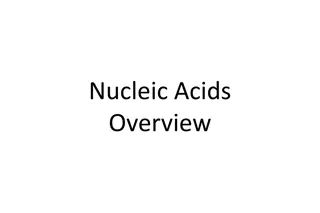Understanding Acids and Bases in Chemistry: Key Concepts and Terminology
This chapter delves into the fundamental concepts of acids and bases in chemistry, covering Arrhenius, Bronsted-Lowry, and Lewis definitions. It discusses conjugate acids and bases, acid dissociation, dissociation of strong and weak acids, and the differences between strong and weak acids/bases. The content also explores dissociation constants and the behavior of strong and weak acids in solution.
Download Presentation

Please find below an Image/Link to download the presentation.
The content on the website is provided AS IS for your information and personal use only. It may not be sold, licensed, or shared on other websites without obtaining consent from the author. Download presentation by click this link. If you encounter any issues during the download, it is possible that the publisher has removed the file from their server.
E N D
Presentation Transcript
Acids and Bases Chapter 14 DE Chemistry Dr. Walker
Acid Base Terminology Arrhenius Acids produce hydrogen ions in aqueous solutions Based produce hydroxide ions in aqueous solutions Bronsted-Lowry Acids are proton donors Bases are proton acceptors Lewis Acids are electron pair acceptors Bases are electron pair donors
Conjugate Acids and Bases + H2O Cl- + H3O+ HCl Acid Base Conjugate Conjugate Base Acid Conjugate Base Formed when acid loses a proton Conjugate Acid Formed when base gains a proton
Acid Dissociation HA H+ + A- Acid Proton Conjugate Base = K a
Acid Dissociation HA H+ + A- Acid Proton Conjugate Base + [ ][ ] H A = Ka [ ] HA -Based on equilbirium constants from last chapter -Ka is very high for strong acids, lower for weak acids
Dissociation of Strong Acids Strong acids are assumed to dissociate completely in solution. Large Ka or small Ka? Reactant favored or product favored?
Dissociation Constants: Strong Acids Conjugate Base ClO4- I- Br- Cl- NO3- HSO4- H2O Acid Formula Ka Perchloric Hydriodic Hydrobromic Hydrochloric Nitric Sulfuric Hydronium ion HClO4 HI HBr HCl HNO3 H2SO4 H3O+ Very large Very large Very large Very large Very large Very large 1.0
Dissociation of Weak Acids Weak acids are assumed to dissociate only slightly (less than 5%) in solution. Large Ka or small Ka? Reactant favored or product favored?
Strong and Weak Acids/Bases Strong Acid dissociates completely in solution -Notice the HCl completely breaks apart -Tends to be smaller molecules Weak Acid dissociates partially in solution Notice the acetic acid stays mostly intact -Tends to be larger, organic molecules
Dissociation Constants: Weak Acids Conjugate Base IO3- HC2O4- HSO3- H2PO4- H2C6H5O7- NO2- F- HCOO- C6H5COO- CH3COO- HCO3- ClO- CN- Acid Formula Ka Iodic Oxalic Sulfurous Phosphoric Citric Nitrous Hydrofluoric Formic Benzoic Acetic Carbonic Hypochlorous Hydrocyanic HIO3 H2C2O4 H2SO3 H3PO4 H3C6H5O7 HNO2 HF HCOOH C6H5COOH CH3COOH H2CO3 HClO HCN 1.7 x 10-1 5.9 x 10-2 1.5 x 10-2 7.5 x 10-3 7.1 x 10-4 4.6 x 10-4 3.5 x 10-4 1.8 x 10-4 6.5 x 10-5 1.8 x 10-5 4.3 x 10-7 3.0 x 10-8 4.9 x 10-10 Lower Ka = less dissociation = weaker acid!!!
Acid Terminology Polyprotic Acids with more than one ionizable proton Monoprotic - one acidic proton (HCl) Diprotic - two acidic protons (H2SO4) Triprotic - three acidic protons (H3PO4) Oxyacids - acids in which the acidic proton is attached to an oxygen atom (HClO3) Ionizable Hydrogen http://withfriendship.com/images/j/45366/of-perchloric-acid.png
Polyprotic Acids When multiple acidic protons are present, the removal of each one gives a different equilibrium constant The first one will always have the highest (strongest) equilibrium constant
Acid Terminology Organic acids - acids containing the mildly acidic carboxyl group Generally weak acids Equilibrium lies far to the left (weak acids) http://boomeria.org/chemlectures/organic/acids.jpg
Self-Ionization of Water H2O + H2O H3O+ + OH- This happens in every glass of water This occurs in low enough concentration that it is not noticeable [H3O+] = [OH-] = 1.0 x 10-7 M [H3O+] [OH-] = 1.0 x 10-14 M
Dissociation of Strong Bases MOH(s) M+(aq) + OH-(aq) Strong bases are metallic hydroxides Group I hydroxides (NaOH, KOH) are very soluble Group II hydroxides (Ca, Ba, Mg, Sr) are less soluble pH of strong bases is calculated directly from the concentration of the base in solution
Calculating pH, pOH pH = -log[H3O+] pOH = -log[OH-] Relationship between pH and pOH pH + pOH = 14 Finding [H3O+], [OH-] from pH, pOH [H3O+] = 10-pH [OH-] = 10-pOH
The pH scale Examples of everyday items
A Weak Acid Equilibrium Problem What is the pH of a 0.50 M solution of acetic acid, HC2H3O2, Ka = 1.8 x 10-5 ? Step #1: Write the dissociation equation HC2H3O2 C2H3O2- + H+
A Weak Acid Equilibrium Problem What is the pH of a 0.50 M solution of acetic acid, HC2H3O2, Ka = 1.8 x 10-5 ? Step #2: ICE it! HC2H3O2 C2H3O2- + H+ I C E 0.50 - x 0.50 0 0 +x +x - x x x
A Weak Acid Equilibrium Problem What is the pH of a 0.50 M solution of acetic acid, HC2H3O2, Ka = 1.8 x 10-5 ? Step #3: Set up the law of mass action HC2H3O2 C2H3O2- + H+ 0.50 - x x x E 2 ( )( ) x x x = 5 8 . 1 10 x . 0 ( 50 ) . 0 ( 50 ) x For weak acids, dissociation is small enough that It is assumed that a weak acid (acetic acid, here), dissociates less than 5%
A Weak Acid Equilibrium Problem What is the pH of a 0.50 M solution of acetic acid, HC2H3O2, Ka = 1.8 x 10-5 ? Step #4: Solve for x, which is also [H+] HC2H3O2 C2H3O2- + H+ E x x 0.50 - x 2 x = 5 8 . 1 10 x [H+] = 3.0 x 10-3 M . 0 ( 50 )
A Weak Acid Equilibrium Problem What is the pH of a 0.50 M solution of acetic acid, HC2H3O2, Ka = 1.8 x 10-5 ? Step #5: Convert [H+] to pH HC2H3O2 C2H3O2- + H+ x E x 0.50 - x = 3= log( 0 . 3 10 ) . 2 52 pH x
Reaction of Weak Bases with Water The base reacts with water, producing its conjugate acid and hydroxide ion: CH3NH2 + H2O CH3NH3+ + OH- Kb = 4.38 x 10-4 + [ ][ ] CH NH OH = = 4 4.38 10 3 CH NH 3 K x b [ ] 3 2
Kb for Some Common Weak Bases Many students struggle with identifying weak bases and their conjugate acids. What patterns do you see that may help you? Conjugate Acid NH4+ CH3NH3+ C2H5NH3+ (C2H5)2NH2+ (C2H5)3NH+ HONH3+ H2NNH3+ C6H5NH3+ C5H5NH+ Base Formula Kb Ammonia Methylamine Ethylamine Diethylamine Triethylamine Hydroxylamine Hydrazine Aniline Pyridine NH3 CH3NH2 C2H5NH2 (C2H5)2NH (C2H5)3N HONH2 H2NNH2 C6H5NH2 C5H5N 1.8 x 10-5 4.38 x 10-4 5.6 x 10-4 1.3 x 10-3 4.0 x 10-4 1.1 x 10-8 3.0 x 10-6 3.8 x 10-10 1.7 x 10-9
A Weak Base Equilibrium Problem What is the pH of a 0.10 M solution of ammonia, NH3, Kb = 1.8 x 10-5 ? Step #1: Write the equation for the reaction NH3 + H2O NH4+ + OH-
A Weak Base Equilibrium Problem What is the pH of a 0.10 M solution of ammonia, NH3, Kb = 1.8 x 10-5 ? Step #2: ICE it! NH3 + H2O NH4+ + OH- I C E 0.10 0 0 +x +x - x 0.10 - x x x
A Weak Base Equilibrium Problem What is the pH of a 0.10 M solution of ammonia, NH3, Kb = 1.8 x 10-5 ? Step #3: Set up the law of mass action NH3 + H2O NH4+ + OH- E 0.10 - x x x 2 ( )( ) x x x = 5 8 . 1 10 x . 0 ( 10 ) . 0 ( 10 ) x
A Weak Base Equilibrium Problem What is the pH of a 0.10 M solution of ammonia, NH3, Kb = 1.8 x 10-5 ? Step #4: Solve for x, which is also [OH-] NH3 + H2O NH4+ + OH- E 0.10 - x x x 2 x = 5 8 . 1 10 x [OH-] = 1.3 x 10-3 M . 0 ( 10 )
A Weak Base Equilibrium Problem What is the pH of a 0.10 M solution of ammonia, NH3, Kb = 1.8 x 10-5 ? Step #5: Convert [OH-] to pH NH3 + H2O NH4+ + OH- E 0.10 - x x x = 3= log( 3 . 1 10 ) . 2 89 pOH x = = 14 00 . 11 11 . pH pOH
Effect of Structure on Acid-Base Properties Hypochlorous acid Chlorous acid Chloric acid Perchloric acid Increasing Acidity (more oxygens)
Acid-Base Properties of Oxides Acidic Oxides (also called acid anhydrides) Nonmetal oxides that react with water to form acidic solutions SO3(g) + H2O(l) H2SO4(aq) 2 NO2(g) + H2O(l) HNO3(aq) + HNO2(aq)
Acid-Base Properties of Oxides Basic Oxides (also called basic anhydrides) Metallic oxides of Group 1A and 2A metals react with water to form basic solutions K2O(s) + H2O(l) 2KOH (aq) CaO(s) + H2O(l) Ca(OH)2(aq)
Titrations Type of quantitative analysis Start with known concentration and volume of a solution, known as a titrant Titrant can be acid or base Add to a sample solution with unknown concentration, known as an analyte Analyte will be the opposite of the titrant Reaches the endpoint when the indicator turns color Indicator: Dye that changes color with a change in pH
A Titration Pictured Left: student performing a titration. The titrant is in a long tube called a buret. The analyte is in the Erlenmeyer flask below. Right: A close-up view of a buret, measuring in 0.1 mL increments.
Calculations The most common calculation involves using dilutions Example: 32.5 mL of 0.1 M HCl solution is required to titrate 100 mL of a base. What is the concentration of the base?
Calculations The most common calculation involves using dilutions Example: 32.5 mL of 0.1 M HCl solution is required to titrate 50 mL of a base. What is the concentration of the base? M1V1 = M2V2 (0.1 M)(32.5 mL) = M2 (50 mL) M2 = 0.065 M
Titration Curves Titration curves depict the change in pH versus the amount of titrant (acid or base) added
Additional Vocabulary Equivalence Point pH where the moles (acid) = moles (base) Notice the equivalence point depends on the strength of the acid being titrated
Titration Curves Notice the difference between the curves Left: The titration of a strong acid has a sharp curve before reaching the equivalence point Right: The titration of the weak acid has a shallow curve prior to the equivalence point
Polyprotic Acids Polyprotic acids have multiple Ka values one for each ionizable proton Each ionizable proton has a separate equivalence point at a different pH
